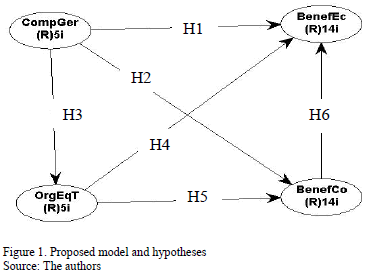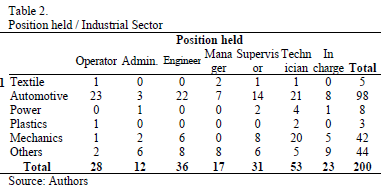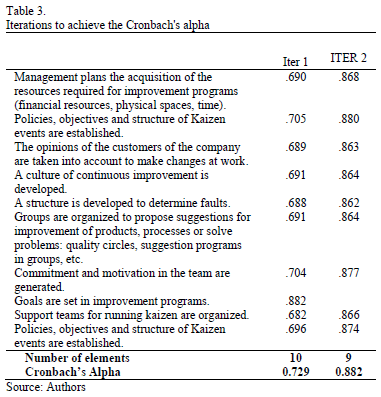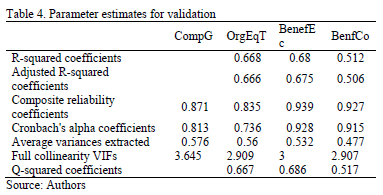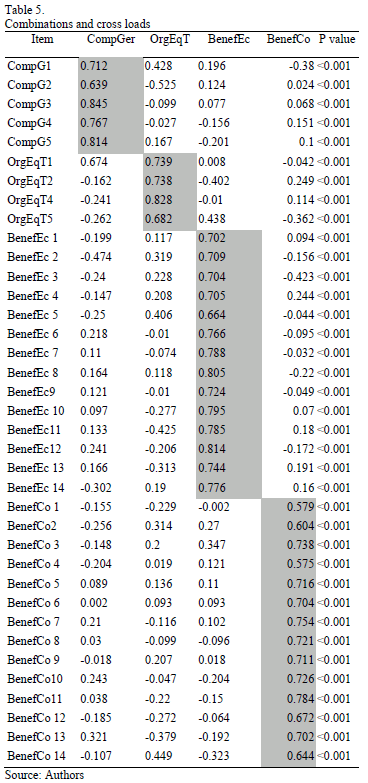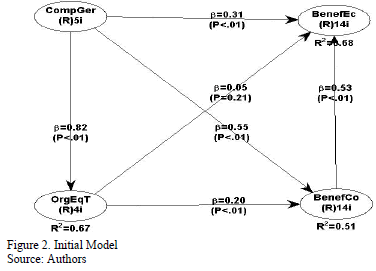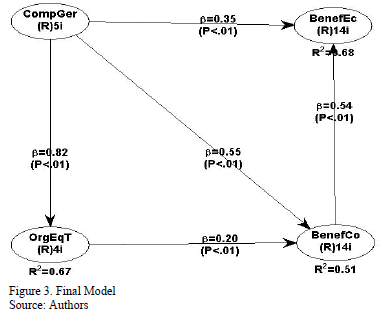Services on Demand
Journal
Article
Indicators
-
 Cited by SciELO
Cited by SciELO -
 Access statistics
Access statistics
Related links
-
 Cited by Google
Cited by Google -
 Similars in
SciELO
Similars in
SciELO -
 Similars in Google
Similars in Google
Share
DYNA
Print version ISSN 0012-7353
Dyna rev.fac.nac.minas vol.82 no.191 Medellín May/June 2015
https://doi.org/10.15446/dyna.v82n191.51157
DOI: http://dx.doi.org/10.15446/dyna.v82n191.51157
Effects of management commitment and organization of work teams on the benefits of Kaizen: Planning stage
Efectos del compromiso gerencial y organización de equipos de trabajo en los beneficios del Kaizen: Etapa de planeación
Midiala Oropesa-Vento a Jorge Luis García-Alcaraz b Leonardo Rivera c & Diego F. Manotas d
a Instituto de Ingeniería y Tecnología, Universidad Autónoma de Ciudad Juárez, México. al132804@alumnos.uacj.mx
b Instituto de Ingeniería y Tecnología, Universidad Autónoma de Ciudad Juárez, México. jorge.garcia@uacj.mx
c,d Escuela de Ingeniería Industrial. Universidad del Valle, Colombia. leonardo.rivera.c@correounivalle.edu.co; diego.manotas@correounivalle.edu.co
Received: January 28th, 2015. Received in revised form: March 26th, 2015. Accepted: April 30th, 2015.
This work is licensed under a Creative Commons Attribution-NonCommercial-NoDerivatives 4.0 International License.

Abstract
This paper presents an analysis of the effects of management commitment and organization of work teams in the benefits of implementing Kaizen in industrial enterprises during planning stages. To gather information, 200 questionnaires were applied to 68 companies distributed in the states of Tabasco, Sinaloa and Chihuahua in Mexico and in the province of Camagüey, Cuba. We used the methodology of least partial squares with the WarpPLS 4.0 software to develop a model of structural equations that explains such effects. The results show that when there is a high level of managerial commitment, this impacts the profits and competitiveness of companies positively. We also found that the organization of work teams has positive impacts on competitive benefits and these, in turn, on economic benefits. As a result of this study, we present the impact of certain critical success factors of Kaizen on the benefits of its implementation, which is a key factor in its sustainability over time.
Keywords: kaizen, management commitment, coordination of teams, partial least squares (PLS).
Resumen
Este trabajo presenta un análisis de los efectos que tienen el compromiso gerencial y la organización de equipos de trabajo en los beneficios de la implementación del kaizen en las empresas industriales durante su etapa de planeación. Para buscar la información se aplicaron 200 cuestionarios a 68 empresas distribuidas en los estados de Tabasco, Sinaloa y Chihuahua en México y también en la provincia de Camagüey. Cuba. Para obtener un modelo de ecuaciones estructurales explicativo de los efectos, se utilizó la metodología de mínimos cuadrados parciales usando WarpPLS 4.0. Los resultados obtenidos muestran que cuando existe un alto compromiso gerencial se tiene impactos positivos en los beneficios económicos y competitivos de las empresas. Asimismo, la organización de equipos de trabajo tiene impactos positivos sobre los beneficios competitivos y estos a su vez sobre los beneficios económicos obtenidos. Como resultado de este estudio se muestra el impacto que tienen determinados factores críticos de éxito del Kaizen, en los beneficios de implementación del mismo, elemento primordial para su sostenibilidad en el tiempo.
Palabras clave: kaizen, compromiso gerencial, organización de equipos de trabajo, mínimos cuadrados parciales (PLS).
1. Introduction
Over the years, Western industries have managed their businesses pursuing short-term goals. This practice prevents them from seeing beyond their immediate needs, and holds them in short-term planning processes. This is short-sighted and limits the levels of quality and profitability they can reach. According to the management teams of Japanese companies, the secret of the most successful companies in the world lies in having high quality standards for their products, processes, services and employees; Therefore, quality is a philosophy that should be applied at all levels in an organization, and this requires a continuous improvement process that should have no end [1-3]. This process enables companies to view a wider horizon, to maintain a permanent pursuit of excellence and innovation, to increase their competitiveness and reduce costs, guiding their efforts to meet the needs and expectations of customers, both internal and external.
Furthermore, this process of continuous improvement requires that the manager behave like a true leader in the organization, ensuring the participation of all the employees, and getting involved in all the processes of the supply chain. To do this, he must commit deeply to this work, since he is responsible for implementing the process and the most important driving force of the company.
To carry out this process of continuous improvement, both in a particular department and across the company, it should be taken into consideration that this process should be: economic (it should require less effort than the benefits it brings), and cumulative, in that each improvement realized will open the possibility of successive improvements while taking full advantage of the new level of performance.
This paper analyzes the impact that managerial commitment and teamwork have on the benefits of continuous improvement systems from the perspective of Kaizen. We also measure the perception of many people at managerial levels around the issues of continuous improvement, and with this, we validate the hypotheses enunciated in the paper.
The paper is organized into 5 sections. After the introduction, Section 2 presents a review of literature associated with Kaizen, in Section 3 we present the design of this research, Section 4 shows the results, and finally Section 5 presents conclusions, limitations and future research.
2. Literature Review
2.1. Kaizen in industry
Companies can obtain significant competitive advantages by successfully implementing Kaizen. The elements that made Kaizen successful in the Toyota Production System are still valid. We could even argue that these elements make Kaizen even more relevant today than in the 70s and 80s, in a competitive environment where speed and efficiency are crucial [1,2].
Kaizen is reported to lead to higher quality and productivity. Kaizen also helps to improve accountability and employee commitment [2, 3]. These results have kept Kaizen as a popular topic in companies around the world [3] and a staple in the scientific literature [3-11].
In today's agitated and uncertain economic environment, in which we are still feeling the aftermath of the financial crisis of 2008 and 2009, many Mexican industrial companies have initiated or increased their efforts to improve their operations. These companies have noticed that the sole reduction of their headcount is not enough, providing fertile ground for the application of philosophies such as Lean Manufacturing and Kaizen [12,13].
The success of Kaizen in companies is due to the fact that it involves every employee in the continuous improvement effort, taking advantage of their contributions to achieve small and gradual changes [14,15]. In this manner, Kaizen centers in the identification of problems, their root causes, the solutions that must be implemented and the change in standards and operational methods required to ensure that the problem does not occur again [16].
There are reports in the literature that state that in established Kaizen programs, each employee submits between 25 and 30 suggestions every year, and that around 90% of them are implemented. Toyota is recognized as a leading company in the application of Kaizen. In 1999, one of the Toyota manufacturing facilities located in the United Stated reported that 7,000 employees submitted over 75,000 suggestions, out of which about 99% was implemented [15].
By measuring the sustainability of Kaizen, the research has tended to emphasize the critical success factors to measure its impact on the economic and competitive benefits of a company. Because the sustainability of Kaizen is measured by attributes or parameters that generate information, it requires all participants to be involved and committed to focusing on common customer satisfaction goals to be effective, allowing them to become more competitive. Therefore, it is essential to have clear and standardized attributes that enable the organization to know which factors have a greater impact on certain benefits, some of which are discussed below.
2.2. Management commitment and organization of work teams in the implementation of Kaizen
People in management positions show no apparent concern for the development of relationships between the management level and the members of the organization, through which the manager may have some positive influence on their behavior [17].
The strategic process, including the development, implementation and monitoring of strategies in the business, reflects the characteristics of the style of leadership in the company. Managers need to implement organizational changes to face new challenges, to ensure that the company adapts to and copes with new circumstances. However, the company and its individuals resist such changes in many ways [18].
Most managers tend to consider several factors such as: company profile, top management orientation, goals and objectives, internal variables, external variables and other factors that appear to be key to determining the success or failure of strategies in the organization. However, issues related to human factors are not considered, such as the development of management skills aimed at creating relationships between managers and people at lower levels to persuade and motivate members of the organization, whose participation is essential for the successful development of the strategy [19].
Consequently, one of the main problems in large and medium industrial enterprises is the lack of leadership in those who have the responsibility to manage the company. Every industrialist has shown a certain degree of leadership, because they have created companies in the market conditions at the time [20]. But these people unfortunately do not view leadership as a quality through which they can influence human factor towards achieving the goals in the company [21].
The prevailing approach to leadership in senior management is to apply those policies and procedures that were useful for the company in the past and assume that they will be useful in the near future. This approach is guided by the idea that the manager can act as a leader exerting power in his managerial position [22]. Other employees do not present their points of view because they perceive this as a high-risk attitude that they are not willing to take [23].
In the current study, activities related to management commitment and work teams and their impact on company profits in implementing the Kaizen are determined, since this commitment from the members of the organization to the goals of a particular strategy in the business, is affected by the lack of motivation to achieve them. Management does not pay attention from to the personal interests of individuals [3,5,20,22].
The type of managerial thinking that is based on rigid patterns considers economic, financial, production, technology and other factors as crucial, relegating to the background concerning the relations that should exist between the different levels of the organization. This issue is the subject of lengthy debates, but limited or no action is taken if it affects the social and economic world of managers and company owners [24,25].
The change in the mindset of managers in these organizations should start with a new approach to leadership in the direction that leads to a change in their philosophical outlook. Thus, the manager will move from a traditional conception of leadership to a new vision that will generate a wider and more accurate perspective of the environment in which the company works.
This new approach to leadership also requires the active and effective participation of the human factor, making the position of the group relevant for the company. This is an important variable because of the effect it has on the process of generating and executing strategies [19,21,23].
The adoption of new managerial behavior, with a new and broader perspective of the organization towards the future, on one hand, and a greater shift towards a sustained relationship with the people who make up the company, on the other; is presented as a management tool, where the greater closeness and trust between people at management level and the other hierarchical levels will increase the level of commitment of the members of the company towards the goals of a particular strategy [26,27,28].
The increase in the level of commitment will be attained when it is understood that people are part of the organization, improving a sense of belonging. Employees will show more interest and effort not by compulsion but by a sincere desire to contribute to achieving the company objectives (developing the sense of belonging) [29, 30, 31].
There are many critical success factors of Kaizen presented in the literature. An in-depth literature search found 235 articles where authors identified 51 critical success factors pertaining to the implementation of Kaizen and 41 types of benefits to do with its implementation. On this basis, we set out to investigate how these critical success factors create an impact on the profits of the company and thus provide solutions that can ensure greater sustainability of Kaizen over time.
To identify the impact of the critical success factors of Kaizen on benefits, in its planning stage, we first took into account two variables for measurement because of the complexity of the model as a whole. The selected variables are management commitment and organization of teams.
On the other hand, is also very important to identify the benefits, and in this sense, the study provides insight into the impact of the two selected variables on company profits.
3. Research Design
3.1. Design of the questionnaire
As a basis for this research, we built a questionnaire taking into account the literature related to the critical success factors for implementation of Kaizen, and the benefits for both customers and businesses. This research was conducted in electronic databases such as Elsevier, Scirus, JSTOR, ScienceDirect, Web of Science, Ebscohost, Ingenta, Springer, Google Scholar, and academic textbooks.
The questionnaire was validated by four experts, two academics and three engineers in the area of continuous improvement and Lean Manufacturing. All of them independently assessed the relevance, consistency, adequacy, clarity, content, knowledge and structure of the written items. Subsequently, a pilot test was conducted applying the questionnaire to 30 engineers working in manufacturing industries in Ciudad Juarez and Los Mochis, in areas of continuous improvement and lean manufacturing.
The questionnaire was divided into three sections, with a total of 51 questions related to Critical Success Factors in the three stages of Kaizen: Thirteen items in the Planning Stage, 22 items for the Execution Stage, and 16 items for the Control Stage.
There are 41 questions related to benefits, with 14 questions for economic benefits, 12 for competitive benefits and 13 for human resources benefits. Also, five questions related to demographic aspects were included.
The questionnaire should be answered on a Likert scale, with values between 1 and 5. Table 1 presents the scale used in the questionnaire, answering the general question "Degree of implementation of the following activities" [32-40].
We chose four variables for this study: Two related to management commitment and organization of work teams and 2 more related to the economic and competitive benefits for the Company. These variables or dimensions have 37 items in total, which are shown in the following list:
Dimension 1: Management Commitment (CompGer)
- Management plans the acquisition of the resources required for improvement programs (financial resources, physical spaces, time)
- Policies, objectives and structure of Kaizen events are established.
- The opinions of company customers are taken into account to make changes at work.
- A culture of continuous improvement is developed.
- A structure is developed to determine faults.
Dimension 2: Organization of Work Equipment (OrgEqT).
- Groups are organized to propose suggestions for improvement of products, processes or to solve problems: quality circles, suggestion programs in groups, etc.
- Commitment and motivation in the team are generated.
- Support teams for running Kaizen are organized.
- Heterogeneity of improvement teams.
Dimension 3: Economic Benefits (BenefEc)
- Reduction of the percentage of defective products
- Decreases in unit manufacturing costs
- Reduction in the time elapsed between the reception of the order and the delivery to the customer as much as possible.
- Increased productivity.
- The company meets deadlines and quantities as promised.
- Reduction of material handling distance.
- Reduction of waste in areas such as inventories, waiting times, transport and movement of workers.
- Reduction of steps in the production process.
- Profit maximization.
- Decrease in failures of equipment and tools.
- High productivity increases.
- Reductions in design and operational cycles.
- Improved cash flows.
- Better economic balance.
Dimension 4: Competitive Benefits (BenefCo)
- The company responds to customer needs.
- IAn increased rate of introduction of new products is perceived.
- Improved product quality.
- The company responds to customer needs.
- Employee skills are improved.
- Reduction in machine setup times.
- A systemic view of the organization is provided.
- Process-oriented thinking is encouraged.
- Improved product design is perceived.
- Increased ability to compete in globalized markets and to continuously adapt to sudden market changes.
- Strategic advantage over its competitors.
- Accumulated knowledge and experiences that are applicable to organizational processes.
- Internal barriers are easily knocked down, thereby allowing powerful and authentic teamwork.
- Capacity to adapt continuously to sudden changes in the market (related to social, cultural, economic, and political factors).
3.2. Data collection process
The final questionnaire was administered in print and electronically via the tool Survey Monkey. We sent it to 68 industrial enterprises in the regions of Villahermosa in Tabasco, Los Mochis in Sinaloa, Ciudad Juarez in Chihuahua, and also in Camagüey, Cuba. The aim of the survey was explained and the enterprises were invited to participate in the research. Suitable candidates to answer the questionnaire were: directors, managers, supervisors, engineers and technicians.
3.3. Information analysis and validation
A database was designed using the SPSS 21.0® software for descriptive analysis of the information. First, for validation purposes, a rational validity was considered, according to [42]. Subsequently, tests for detecting missing values were performed and given that the data came from an ordinal scale (Likert), they were replaced by the median. Similarly, a test was performed to identify outliers, by standardizing the data, considering in the analysis standardized absolute values below 3.3. In addition, a statistical validation of the dimensions was performed by calculating the Cronbach Alpha Index (IAC) to determine the internal consistency of the items. When the IAC has values greater than or equal to 0.70 the dimension is considered important [44-50].
In this validation process, we also used the average extracted variance (VME), used to assess the discriminant and convergent validity between items. We also analyzed the combined cross-factorial loadings to assess the discriminant validity for each dimension. At this stage it was considered that the point of acceptable cut off for the factor loadings of the items should be 0.50, also evaluating the significance of the P-value of the item in the dimension.
To evaluate the presence of collinearity between latent variables, we considered the index of inflation of variance (VIF) and we used values less than 10 as cut-off points, or having the coefficient of correlation between the dimensions (r-value)with a value of less than 0.90. Because of the nature of the questionnaire items presented in ordinal scale, we used the Q2ratio as a nonparametric measure of predictive validity. Q2must be greater than zero to be considered as an acceptable prediction of the model.
3.4. Structural equation model
Structural Equation Models (Structural Equation Modeling, SEM) provide a general framework for statistical analysis of the relationships between several variables. Techniques such as factor analysis and multiple regression can be considered specific categories in the application of structural equation models.
The measured variables, also called observed variables or indicators, are variables that can be observed and measured directly. Latent variables cannot be observed directly, and must be inferred from their effects on the observed variables. The latent variables are also called constructs, factors (factor analysis) or unobserved variables.
In structural equation models, one of the most interesting features is that they allow the estimation of the indirect and total effect one variable can have on another, not only the direct impact as in linear regression. There are three types of effects [51].
The proposed model and hypotheses that reference the dimensions described above are shown in Fig. 1. For their modeling and validation we used WarpPLS 4.0 ® software, whose algorithms used to calculate the estimators of the relationships between variables are based on Partial Least Squares (PLS). We chose this technique given that when modeling with PLS we require less demanding assumptions about sample size and data distribution. The WarpPLS4 algorithm uses a resampling method (bootstrapping) to reduce the effects of convergence.
The model in Fig. 1 proposes the direct effects of CompG (management commitment) on OrgEqt (organizing teams), the BenefEc (economic benefits) and BenefCo(competitive benefits) a, as well as the direct effects of OrgEqt(organization of teams) with BenefEc (economic benefits) and BenefCo (competitive benefits).
These relationships are proposed based on experience and the study of literature, that say that what any company ultimately pursues is economic benefit, so that the relationships between its variables are aimed in that direction.
We will consider that a relationship is valid when each segment or line joining two latent variables shows a beta value and P value of less than 0.05.
To evaluate the fit of the model, the hypotheses must be validated considering the P-value of the estimated value in each intended effect.
The hypotheses are:
H1 The management commitment will have a direct and positive impact on the economic benefits of the company.
H2 The management commitment will have a direct and positive effect on the competitive benefits of the company.
H3 The management commitment will have a direct and positive impact on the organization of work teams in the company.
H4 The organization of work teams will have a direct and positive impact on the economic benefits of the company.
H5 The organization of work teams will have a direct and positive effect on the competitive benefits of the company.
H6 The economic benefits will have a direct and positive effect with the competitive benefits of Kaizen.
4. Results
4.1. Description of the sample
A total of 200 completed questionnaires were collected. Of these, 57 were through the electronic tool Survey Monkey and 143 through paper surveys.
Of the collected surveys, 134 were answered by men and 66 by women. Table 2 presents a descriptive analysis of the sample, with the industrial sector and the position held by respondents. We can observe that 36 of the respondents are engineers focused on working on continuous improvement processes, 53 are technical assistants, 28 are operators with extensive experience in the implementation of Kaizen, 31 supervisors and 17 managers, among others.
Furthermore, 98 respondents were employed in the automotive sector, while 42 belong to the mechanical industry
4.2. Validation of the instrument
The statistical validation of the reliability of the instrument was performed by calculating the Cronbach Alpha index.
To find the consistency and correlation among items the Cronbach's Alpha index was calculated, as shown in Table 3. This analysis considered primarily a total of 10 items related to the study variables; management commitment and organization of teams.
When calculating Cronbach's Alpha, a score of 0.729 is obtained, and we found that we could increase the reliability by eliminating an item, number 8 "goals are set in improvement programs," leaving a total of 9 items and a Cronbach's alpha of 0.882.
It is also observed in Table 3 that all values are greater than 0.7; thus, representing that the instrument has good consistency [52].
In Table 4, we can see the estimation of the parameters for the validation. It is observed that the average values of the extracted variance (AVE) are greater than 0.5, this indicates that the questionnaire is convergent and has discriminant validity. Considering the R2 for the latent variables, we found acceptable values. When evaluating the VIF index we observed values below 3.3, indicating independence between the latent variables.
Regarding Q2, we observed values greater than zero, indicating a good predictive model. Table 5 shows the combined and crossed factorial loadings of the items to evaluate the saturation of each dimension, considering that they must have values greater than 0.50 in the corresponding variable and lower on the crossed factorial loadings (another variable). It is noted that the P-value is significant (<0.05) for all items, confirming the convergent validity of the questionnaire [53].
4.3. Structural equation model
In the modeling undertaken using WarpPLS 4.0®, three effects were analyzed: i) the direct effects to test the hypotheses; ii) indirect effects; and iii) the total effects.
4.3.1. Direct effects
The direct effects of the model are presented in Fig. 2, for each relationship between dimensions, we present a measurement value for dependence expressed by b and in brackets the P-value for each hypothesis test.
The initial model proposed was assessed, based on the hypotheses displayed in Fig. 2. The test presented an R2 value of 68 for the economic benefits variable and an R2 of 51 for the competitive benefits. In this model, we observe significant relationships with values of less than 0.05; however, there is one exception: The relationship between OrgEqT (organization of work teams) and BenefEc (economic benefits), which presents a P-value greater than 0.05, which generates the need to modify the model as initially proposed.
Once we developed the model, we removed non-significant relationships, those with values above 0.05, and proceeded to remove them iteratively. We removed the relationship between CompG (management commitment) and BenefEc (economic benefits) because it has a P-value of 0.21 and a beta close to zero. The model without this relationship is presented in Fig. 3.
For this new model, we can observe that all relationships are significant, with P-values smaller than 0.05. For example, the relationship linking the CompG (management commitment) to BenefCo (competitive benefits) has a b = 0.55 and P <0.01, which means that when the standard deviation of the first dimension increases by one unit, the second dimension increases its standard deviation by 0.55. This also represents its measure of dependence.
The same interpretation is applicable to other relationships. It is important to notice that the highest dependence (according to the value of b) is observed between CompG (management commitment) and OrgEqT (organization of work teams) with b = 0.82.
4.3.2. Indirect effects
Table 6 shows the sum of indirect effects. It is important to note that all effects between dimensions are significant, since their P-values were less than 0.05. For example, although there is no direct relationship between OrgEqT and BenefEc, there is an indirect effect of 0.105, indicating that when the standard deviation of the first dimension is increased by in one unit, the standard deviation of the second dimension increases by 0.105. The highest indirect effects are those between CompG and BenefEc with a value of 0.420.
.3.3. The total effects
Table 7 presents the sum of the direct effects and the sum of indirect effects that comprise the total effects. The total effect between competitive benefits and economic benefits is 0.535, i.e. when the standard deviation of the first variable increases by one unit, the standard deviation of the second one goes up by 0.535 units.
5. Conclusions
5.1. Conclusion on hypothesis stage planning
Based on the hypotheses we proposed, presented in Fig. 1, we have the following conclusions:
H1 There is enough statistical evidence to say that management commitment has a positive direct effect on the economic benefits for the company, because when the first latent variable increases by one standard deviation, the standard deviation of the second variable increases by 0.35 units.
H2 There is enough statistical evidence to say that management commitment will have a direct and positive effect on the competitive benefits of the company, because when the first latent variable increases by one standard deviation, the second one increases by 0.55 units.
H3 There is enough statistical evidence to say that management commitment has a positive direct effect on the organization of teams, because when the first latent variable or dimension increases by one standard deviation increase by 0.82-second units.
H4 There is enough statistical evidence to say that the organization of work teams does not have a direct positive impact on the economic benefits of the company, because when the first latent variable increases by one standard deviation, the second one increases by 0.05 units. However, there is evidence to say that the organization of work teams has a positive indirect effect on the economic benefits for the company by 0.105.
H5 There is enough statistical evidence to say that the organization of work teams has a positive direct effect on the competitive benefits of the company, because when the first latent variable increases by one standard deviation, the second one increases by 0.20 units.
H6 There is enough statistical evidence to say that competitive benefits have a direct and positive impact on the economic benefits of the company, because when the first latent variable increases by one standard deviation, the second one increases by 0.54 units.
5.2. Industrial implications of the results
The results contribute to the identification of critical success factors and benefits of Kaizen and the features that are most strongly related to the sustainability and results of Kaizen.
For the authors, this is the first study that tests the causal relationships between sustainability performance and the critical success factors of Kaizen.
Such understanding will increase the likelihood that the results of Kaizen implementations are sustained, eliminating wasted efforts and supporting improvement in the organization.
All this leads to an economic contribution, given by the reduction in failures of equipment and tools, reduced machinery setup times, increased levels of customer satisfaction and consumers, increased levels of inventory turnover, significant drop in levels of faults and errors, lower levels of waste and an overall better financial balance.
5.3. Limitations of the study
This work focused on assessing the impacts of management commitment and organization of work teams on company benefits in the regions of Tabasco, Sinaloa, Juarez, Chihuahua in Mexico and Camagüey, Cuba. However, extending the study to other regions will enable researchers to find comparative models supporting the validity of analysis reported here.
5.4. Future Research
We recommend that the same questionnaire be applied to other regions, both inside and outside of Mexico, to extrapolate and find better answers with respect to the impact of the critical success factors of Kaizen on company benefits.
It would be also advisable to consider other types of businesses and industries in order to analyze these effects and compare the results from another perspective.
References
[1] Kumar, S. and Harms, R., Improving business processes for increased operational efficiency: A case study, Journal of Manufacturing Technology Management, 15 (7), pp. 662-674, 2004. DOI: 10.1108/17410380410555907 [ Links ]
[2] Ramadani, V. and Gerguri, S., Theoretical framework of innovation and competitiveness and innovation program in Macedonia. European Journal of Social Sciences, 23 (2), pp. 268-276, 2011. [ Links ]
[3] Medina, C. and Espinosa, M., Innovation in modern organizations. Management and Strategy, 5, pp. 85-102, 1994. [ Links ]
[4] Cooney, R. and Sohal, A., Teamwork and total quality management: A durable partnership. Total Quality Management & Business Excellence, 15 (8), pp. 1131 - 1142, 2004. DOI: 10.1080/1478336042000255442 [ Links ]
[5] Gondhalekar, S., Babu, S. and Godrej, N., Towards using Kaizen process dynamics: A case study. International Journal of Quality & Reliability Management, 12 (9), pp. 192-209, 1995. DOI: 10.1108/02656719510101286 [ Links ]
[6] Bateman, N., Sustainability: The elusive element of process improvement. International Journal of Operations & Production Management, 25 (3), pp. 261-276, 2005. DOI: 10.1108/01443570510581862 [ Links ]
[7] Van de Ven, A., Central problems in the management of innovation. Management Science 32 (5), pp. 590-607, 1996. DOI: 10.1287/mnsc.32.5.590 [ Links ]
[8] Burch, M.K, Lean Kaizen events and longevity determinants of sustainable improvement, Doctoral Dissertation, University of Massachusetts, Amherst, USA, 2008. [ Links ]
[9] Sheridan, J.H., A new attitude. Industry Week, 249 (10), pp.16, 2000. [ Links ]
[10] Daniel, D., Management information crisis. Harvard Business Review, 39, pp. 110-121, 1961. [ Links ]
[11] Terziovski, M. and Sohal, A.S., The adoption of continuous improvement and innovation strategies in Australian manufacturing firms Lithuania. Technovation, 20 (10) pp. 539-550, 2000. DOI: 10.1016/S0166-4972(99)00173-X [ Links ]
[12] Juran, J., Juran on leadership for quality. A manual for managers. Madrid, Spain: Díaz Santos, 1990 [ Links ]
[13] Suarez, B. and Miguel, J., In search of an area of sustainability: An empirical study of the implementation of the Continuous Improvement Process in Spanish Town Councils. INNOVATE Journal of Administrative and Social Sciences, 19 (35), pp. 47-64, 2009. [ Links ]
[14] Barraza, M.F., Smith, T. and Dahlgaard-Park, S.M., Lean Kaizen public service: An empirical approach in Spanish local governments, The TQM Journal, 21 82) pp.143-167, 2009. [ Links ]
[15] Lefcovich, M., Advantages and benefits of Kaizen. [on line], 2007. [date of reference: September 10th of 2011]. Available at: http://www.tuobra.unam.mx/published/040816180352.html [ Links ]
[16] Vonk, J., Business process improvement through Kaizen permits, Spectrum, 78 (2), pp. 33-34, 2005. [ Links ]
[17] Watson, L., Striving for continuous improvement with fewer resources. Kaizen, Marshall Star, pp. 1-5, 2002. [ Links ]
[18] Wheatley, B., Innovation, ISO registration, CMA, 72 (5), pp.23-23, 1998. [ Links ]
[19] Tenenhaus, M., Component-based structural equation modelling. Total Quality Management & Business Excellence. 19 (7-8), pp 87-886, 2008. DOI: 10.1080/14783360802159543 [ Links ]
[20] Woodman, R., Saweyr, J. and Griffin, R., Toward a theory of organizational creativity. Academy of Management Review 18 (2), pp. 293-321, 1993. DOI: 10.2307/258761, 10.5465/AMR.1993.3997517 [ Links ]
[21] Bhatnagar, R. and Sohal, A.S., Supply chain competitiveness: Measuring the impact of location factors, uncertainty and manufacturing practices. Technovation, 25 (5), pp. 443-456, 2005. DOI: 10.1016/j.technovation.2003.09.012, 10.1016/S0166-4972(03)00172-X [ Links ]
[22] Romero, R., Noriega, S., Escobar, C. and Avila, D., Critical success factors: A competitiveness strategy. CULCYT, 6 (31), pp. 5-14, 2009. [ Links ]
[23] Nordgaard, A., Ansell, R., Jaeger, L. and Drotz, W., Ordinal scales of conclusions for the value of evidence. Science and Justice, 50 (1), pp. 31-31, 2010. DOI: 10.1016/j.scijus.2009.11.025 [ Links ]
[24] Hair, J.F., Ringle, C.M. and Sarstedt, M., PLS-SEM: Indeed a silver bullet. Journal of Marketing Theory and Practice, 19 (2), pp. 139-151, 2011. DOI: 10.2753/MTP1069-6679190202 [ Links ]
[25] Rigdon, E.E., Rethinking partial least squares path modeling: In praise of simpler methods. Long Range Planning, 45 (5,6), pp. 341-358, 2011. [ Links ]
[26] Yuan, K. and Bentler, P., New developments and techniques in structural equation modeling. New Jersey, Lawrence Erlbaum Associates, Publishers. USA. 2001. [ Links ]
[27] Dale, B., Boaden, R., Willcox, M. and McQuater, R., Sustaining total quality management: What are the key issues. TQM Magazine, 9 (2), pp. 372-380, 1997. DOI: 10.1108/09544789710178668 [ Links ]
[28] Suarez, B., Michael, J. and Castillo, I., The implementation of Kaizen in Mexican organizations. An empirical study. GCG, 5 (4), pp. 60-74. 2011. [ Links ]
[29] Han, S.B., The effects of ISO 9000 registration efforts on total quality management practices and business performance. PhD. Thesis, University of Rhode Island, Rhode Island, United States, 151 P., 2000. [ Links ]
[30] Swamidass, P.M., A comparison of the plant location strategies of foreign and domestic manufacturers in the U.S., Journal of International Business Studies, 21 (2), pp. 310-316, 1998. [ Links ]
[31] Martin, K.. Kaizen-White collar: Events rapid improvement office, services and technical processes, IIE Annual Conference and Exhibition, Nashville, TN, May 22, 2007. [ Links ]
[32] Ortiz, C., All out Kaizen: A continuous improvement plan delivers change to the production floor and dollars to the bottom line. Industrial Engineer, 38 (4), pp.30-30, 2006. [ Links ]
[33] Bicheno, J., Kaizen and Kaikaku. Manufacturing operations and supply chain management: The LEAN approach, in: Taylor, D., and Brunt, D., eds, London, UK. Thomson Learning, pp. 175-184. 2001. [ Links ]
[34] Terziovski, M. and Sohal, A.S., The adoption of continuous improvement and innovation strategies in Australian manufacturing firms Lithuania. Technovation, 20 (10) pp. 539-550, 2000. DOI: 10.1016/S0166-4972(99)00173-X [ Links ]
[35] Shumacker, R.E. and Lomax, R.G., A Beginner's guide to structural equation modeling. 3A. Ed., LLC Inc. New York, Taylor and Francis Group, 2010, 2 P. [ Links ]
[36] Khurana, A. and Talbot, B., The internationalization process model-through the lens of the global color picture tube industry. Journal of Operations Management, 16 (2-3), pp.215-239, 1998. DOI: 10.1016/S0272-6963(97)00039-9 [ Links ]
[37] Lionnet, P., Innovation: The Process, ESA Training Workshop. Lisbon, 2003. [ Links ]
[38] Olaya, A. The economics of innovation and technological change: A theoretical approach from the Schumpeterian thought. Strategic Sciences Journal, 16 (20), pp. 237-246, 2008. [ Links ]
[39] Sheridan, J.H., Kaizen Blitz, Industry Week, 246 (16), pp.18-27, 1997. [ Links ]
[40] Sabatini, J., Turning Japanese, Automotive Manufacturing & Production, 112 (10), pp. 66-69, 2000. [ Links ]
[41] Rigdon, E.E., Rethinking partial least squares path modeling: in praise of simpler methods. Long Range Planning, 45 (5,6), pp. 341-358, 2011. [ Links ]
[42] Correa-E., A. and Gómez-M., R.A., Information technologies in the supply chain. DYNA, 76 (157), pp.37-48, 2009. [ Links ]
[43] Creswell, J., America's Elite Factories, Fortune, 144 (4), pp. 206A-206L, 2001. [ Links ]
[44] Tabachnick, B.G. and Fidell, L.S., Using multivariate statistics. 4th Ed., Allyn & Bacon, Boston, 2001, P. 77. [ Links ]
[45] Nemoto, M., Total quality control for management. Strategies and techniques from Toyota and Toyoda Gosei. New Jersey: Prentice Hall.Inc., 1987. [ Links ]
[46] Brown, M., Guide to data analysis. Madrid: McGraw-Hill, 2002. [ Links ]
[47] Garza, E., Kaizen continuous improvement. Redalyc.Org, 8 (3), pp. 330-333, 2005. [ Links ]
[48] Martinez, A.C.L., Self-report reading strategy used among Spanish university students of English. RESLA, 21, pp. 161-179, 2008. [ Links ]
[49] Hernández, R., Fernandez, C. and Baptista, P., Research methodology. McGraw-Hill Publishing, Mexico, 1991. [ Links ]
[50] Manos, A., Lean Kaizen: A simplified approach to process improvement. ASQ Quality Press, pp. 47-49, 2006. [ Links ]
[51] Avelar-Sosa, L., García-Alcaraz, J.L., Cedillo-Campos, M.G. and Adarme-Jaimes, W., DYNA, 81 (186), pp. 208-217, 2014. DOI: 10.15446/dyna.v81n186.39958 [ Links ]
[52] Cronbach, L.J., Coefficient alpha and the internal structure of tests. Psychometrika, 16 (3), pp.297-334, 1951. DOI: 10.1007/BF02310555 [ Links ]
[53] García-Rivera J.L., Iniesta, D.G., Alvarado, A., Critical success factors for Kaizen implementation in manufacturing industries in Mexico. The International Journal of Advanced Manufacturing Technology, 68 (1-4) pp. 537-545, 2013. DOI: 10.1007/s00170-013-4750-2. [ Links ]
M. Oropesa-Vento, is a student of the Doctoral program in Engineering at Universidad Autónoma de Ciudad Juárez, México. She is a professor of engineering in the area of quality systems at Universidad Autónoma Indígena of Mexico. She has worked on projects in the area of Lean and Continuous Improvement (Kaizen) in manufacturing companies and has published several works in scientific journals and at international conferences. She is currently is a researcher recognized by the National Council for Science and Technology of Mexico (CONACYT). She received her MBA from the University of Camagüey (Cuba). Her main research areas are related to total quality management, continuous improvement, decision-making and modeling applied to production processes.
J.L. García-Alcaraz, is a Research Professor in the Department of Industrial Engineering at the Universidad Autónoma de Ciudad Juárez in México. He is a founding member of the Mexican Society of Operations Research and an active member of the Mexican Academy of Engineering. Dr. Garcia is a researcher recognized by the National Council of Science and Technology of Mexico (CONACYT) through the National System of Researchers at level 1. He received an M.S. in Industrial Engineering from the Instituto Tecnológico de Colima (Mexico), a PhD. in Industrial Engineering from the Instituto Tecnológico de Ciudad Juárez (Mexico) and a Post-Doctorate at Universidad de La Rioja (Spain). His main research areas are related to multi-criteria decision making and modeling applied to production processes. He is a co-author of over 100 articles published in journals, conferences and congresses.
L. Rivera, is an Assistant Professor at the School of Industrial Engineering, Universidad del Valle, in Cali, Colombia. He holds a B.S. in Industrial Engineering from Universidad del Valle, an M.S.I.E. from the Georgia Institute of Technology and a PhD. in Industrial and Systems Engineering from Virginia Polytechnic Institute and State University. His research interests include Logistics, Operations Research, Lean Manufacturing and the Economic impact of operational decisions.
D.F. Manotas, is an Associate Professor at the School of Industrial Engineering, Universidad del Valle, in Cali, Colombia. He holds a B.S. in Industrial Engineering from Universidad del Valle, an M.S. in Finance from Universidad de Chile and a PhD. in Engineering from Universidad del Valle. His research interests include the financial impact of operational and logistics decisions, multi-criteria decision methodologies, and operational and financial risk in supply chains.














